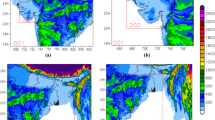Abstract
Devastation due to thunderstorms ensues every year during the pre-monsoon months of April and May over Kolkata (22°32′ N, 88°20′ E), India. Such thunderstorms emerge from large vertical extent of cumulonimbus cloud and are associated with high speed wind squall, at times, exceeding 100 km h−1, deadly lightning flashes and heavy rainfall. The analyses of 102 such thunderstorms have been carried out in this study for morphological classification of thunderstorms over Kolkata, India, during the pre-monsoon season with bulk Richardson number and Byers and Braham theory of 0–6 km wind shear. The result reveals that according, to bulk Richardson number, 85 multicell and 17 supercell thunderstorms, whereas according to Byers and Braham theory, 33 single-cell, 59 multicell and 10 supercell thunderstorms prevailed over Kolkata during the period from 1997 to 2008 in the pre-monsoon season. The coupling of the two approaches together lead to classify the thunderstorms of Kolkata during the pre-monsoon season in two categories: super- and multicell thunderstorms. The result reveals that, out of 102 thunderstorms during the period from 1997 to 2008 in the pre-monsoon season, only 4 are of supercell category and the rest of 98 thunderstorms are of multicell category, depicting the dominance of multicell thunderstorms over Kolkata in the pre-monsoon season. The stability indices and other meteorological parameters are computed and compared for both the categories to identify the threshold ranges pertaining to reveal the climatology and to assess the predictability of both the categories. The result is validated with the observations of India Meteorological Department and Doppler Weather Radar imageries for the years 2009, 2010, 2011, and 2012.
















Similar content being viewed by others
References
Anderson T, Anderson M, Jacobson C, Nilsson S (1989) Thermodynamic indices for forecasting thunderstorms in southern Sweden. Meteor Mag 118:141–146
Anthes RA (1976) Numerical prediction of severe storms—certainty, probability, or dream? Bull Amer Met Soc 57:423–430
Basu GC, Mondal DK (2002) A forecasting aspect of thundersquall over Calcutta and its parameterization during pre-monsoon season. Mausam 53(3):271–280
Byers HR, Braham RR (1948) Thunderstorm structure and circulation. J Meteorol 5:71–86
Chaudhuri S (2008a) Identification of the level of downdraft formation during severe thunderstorms: a frequency domain analysis. Meteorol Atmos Phys 102:123–129
Chaudhuri S (2008b) Preferred type of cloud in the genesis of severe thunderstorms—a soft computing approach. Atmos Res 88(2):149–156
Chaudhuri S (2010) Convective energies in forecasting severe thunderstorms with one hidden layer neural net and variable learning rate back propagation algorithm. Asia-Pac J Atmos Sci 46(2):173–183
Chaudhuri S, Middey A (2009) Applicability of bipartite graph model for thunderstorms forecast over Kolkata. Adv Meteorol 2009:1–12
Chaudhuri S, Middey A (2011a) Nowcasting thunderstorms with graph spectral distance and entropy estimation. Meteorol Appl 18(2):238–249
Chaudhuri S, Middey A (2011b) Adaptive neuro-fuzzy inference system to forecast peak gust speed during thunderstorms. Meteorol Atmos Phys. doi:10.1007/s00703-011-0158-4
De AC, Sen SN (1961) A radar study of pre-monsoon thunderstorms (norwesters) over Gangetic West Bengal. Indian J Meteorol Geophys 12(51–55):4
Desai BN (1950) Mechanism of Nor'westers of Bengal. Indian J Meteorol Geophys 1(1):74–76
Doswell CA (1987) The distinction between large-scale and mesoscale contribution to severe convection: a case study example. Wea Forecast 2:3–16
Jacovides CP, Yonetani T (1990) An evaluation of stability indices for thunderstorm prediction in Greater Cyprus. Weather Forecast 5(4):559–569
Koteswaram P, Srinivasan V (1958) Thunderstorms over Gangetic West Bengal in the pre-monsoon season and the synoptic factors favourable for their formation. Indian J Meteorol Geophys 9(4):301–312
Lee RR, Passner JE (1993) The development and verification of TIPS: an expert system to forecast thunderstorm occurrence. Wea Forecast 8:271–280
Lilly DK (1990) Numerical prediction of thunderstorms—has its time come? Quart J Roy Meteor Soc 116:779–798
Neumann CJ (1971) The thunderstorm forecasting system at the Kennedy Space Center. J Appl Meteorol 10:921–936
Orlanski I (1975) A rational subdivision of scales for atmospheric processes. Bull Am Meteorol Soc 56(5):527–530
Reap RM, Foster DS (1979) Automated 12–36 hour probability forecasts of thunderstorms and severe local storms. J Appl Meteor 18:1304–1315
Schultz P (1989) Relationship of several stability indices to convective weather events in Northest Colorado. Wea Forecast 4:73–80
Stone HM (1985) A comparison among various thermodynamic parameters for the prediction of convective activity, Part I. NOAA Technical Memorandum, NWS-ER 68, Washington
Weisman ML, Klemp JB (1987) Characteristics of isolated convective storms. In: Ray P (ed) Mesoscale meteorology and forecasting, vol 15. American Meteorological Society, Boston, pp 504–520
Acknowledgments
Authors acknowledge India Meteorological Department (IMD) and University of Wyoming for making data available for research. Thanks are due to the anonymous reviewers for their constructive criticisms to enhance the clarity of the paper.
Author information
Authors and Affiliations
Corresponding author
Rights and permissions
About this article
Cite this article
Chaudhuri, S., Goswami, S. & Middey, A. Morphological classification pertaining to validate the climatology and category of thunderstorms over Kolkata, India. Theor Appl Climatol 116, 61–74 (2014). https://doi.org/10.1007/s00704-013-0936-7
Received:
Accepted:
Published:
Issue Date:
DOI: https://doi.org/10.1007/s00704-013-0936-7




